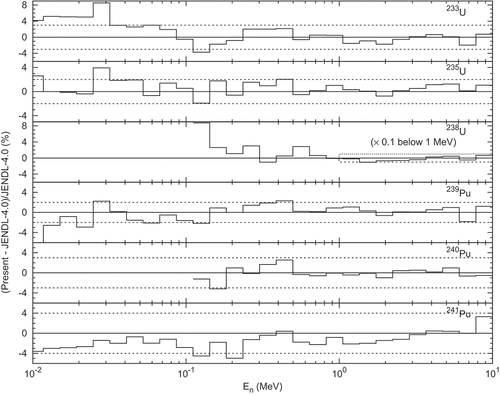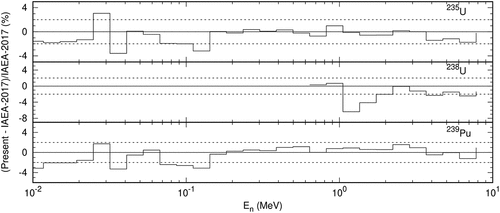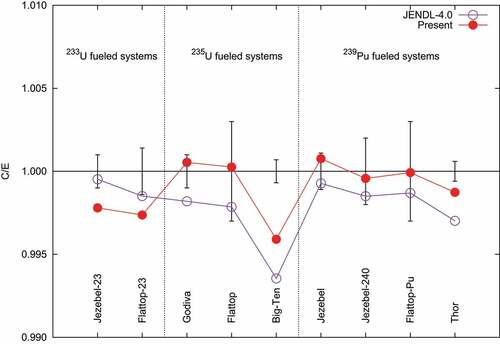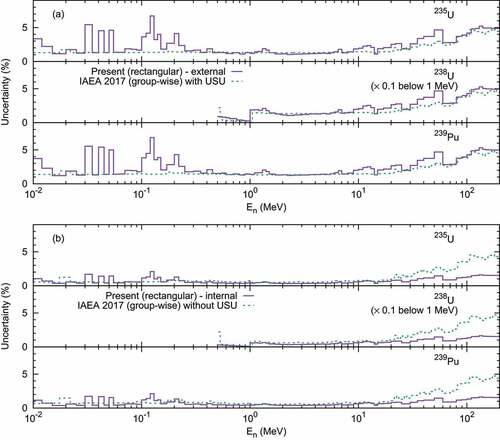Figures & data
Table 1. Evaluation procedures of 233,235,238U and 239,240,241Pu fast neutron fission cross sections in recent general purpose libraries.
Table 2. Number of experimental datasets of fission cross sections and their ratios for final fitting.
Table 3. Absolute fission cross sections (in barns) from the TUD-KRI collaboration and adopted in present evaluation. ‘’ gives the incident energy in MeV and ‘Lab.’ gives the location of the experiment. The underline indicates presence of several cross sections at the same energy from the same laboratory. The parenthesized value refers to the last digits of the uncertainty value (e.g. 1.240(24) means 1.240
0.024). The incident energy value may slightly vary depending on the article when the same measurement is published twice or more.
Table 4. Normalization uncertainties not coded in the EXFOR entries but used in the current evaluation. ‘Unc.’ gives the uncertainty in %.
Figure 1. Fitting of the logarithm of experimental cross section to Schmittroth’s roof function
[Citation161].
![Figure 1. Fitting of the logarithm of experimental cross section Σexp to Schmittroth’s roof function Δ [Citation161].](/cms/asset/3cc5394e-0198-4987-8dfe-4515a339782f/tnst_a_2030259_f0001_b.gif)
Figure 2. Fitting to the LANSCE 241Pu(n,f)/235U(n,f) cross section ratio (EXFOR 14271.006.1) [Citation124] with strong correlation (i.e. all partial uncertainties other than the statistical uncertainty are treated as fully correlated) and weak correlation (i.e. all partial uncertainties other than the normalization uncertainty are treated as uncorrelated). Note that the experimental data points below 1 MeV were discarded in the present evaluation.
![Figure 2. Fitting to the LANSCE 241Pu(n,f)/235U(n,f) cross section ratio (EXFOR 14271.006.1) [Citation124] with strong correlation (i.e. all partial uncertainties other than the statistical uncertainty are treated as fully correlated) and weak correlation (i.e. all partial uncertainties other than the normalization uncertainty are treated as uncorrelated). Note that the experimental data points below 1 MeV were discarded in the present evaluation.](/cms/asset/550e5cea-c27b-4de8-b8ae-b4056f3e259a/tnst_a_2030259_f0002_oc.jpg)
Figure 3. Comparison of the LANSCE 241Pu(n,f) cross section (EXFOR 14271.005) and 241Pu(n,f)/235U(n,f) cross section ratio (EXFOR 14271.006.1) [Citation124] with other datasets. The cross section ratio from LANSCE is normalized to the ratio at 25.3 meV by Tovesson et al. The absolute cross section is converted from the ratio by using the ENDF/B-VII library by Tovesson et al.
![Figure 3. Comparison of the LANSCE 241Pu(n,f) cross section (EXFOR 14271.005) and 241Pu(n,f)/235U(n,f) cross section ratio (EXFOR 14271.006.1) [Citation124] with other datasets. The cross section ratio from LANSCE is normalized to the ratio at 25.3 meV by Tovesson et al. The absolute cross section is converted from the ratio by using the ENDF/B-VII library by Tovesson et al.](/cms/asset/04ccd586-821b-47aa-b398-cbdaea2396bd/tnst_a_2030259_f0003_oc.jpg)
Figure 4. 233U fission prior and posterior cross sections with the experimental cross sections used for evaluation [Citation47–58]. The prior cross section is taken from JENDL-4.0 (below 20 MeV) and Yavshits’ evaluation (above 20 MeV).
![Figure 4. 233U fission prior and posterior cross sections with the experimental cross sections used for evaluation [Citation47–58]. The prior cross section is taken from JENDL-4.0 (below 20 MeV) and Yavshits’ evaluation (above 20 MeV).](/cms/asset/6193027f-9a64-4795-9a56-dddc5501ea7b/tnst_a_2030259_f0004_oc.jpg)
Figure 5. 233U/235U fission prior and posterior cross section ratios with the experimental cross section ratios used for evaluation [Citation59–69]. The prior cross section is taken from JENDL-4.0 (below 20 MeV), Yavshits’ evaluation (above 20 MeV, 233U) and JENDL-4.0/HE (above 20 MeV, 235U).
![Figure 5. 233U/235U fission prior and posterior cross section ratios with the experimental cross section ratios used for evaluation [Citation59–69]. The prior cross section is taken from JENDL-4.0 (below 20 MeV), Yavshits’ evaluation (above 20 MeV, 233U) and JENDL-4.0/HE (above 20 MeV, 235U).](/cms/asset/36ce7bc2-7823-4ecb-acc6-3550cf5b7878/tnst_a_2030259_f0005_oc.jpg)
Figure 6. 235U fission prior and posterior cross sections with the experimental cross sections used for evaluation [Citation52–86]. The prior cross section is taken from JENDL-4.0 (below 20 MeV) and JENDL-4.0/HE (above 20 MeV). In the legends of Amaducci et al.’s datasets, 6Li and 10B denote the cross sections normalized with the 6Li(n,t)4He and 10B(n,)7Li standard cross sections, respectively.
![Figure 6. 235U fission prior and posterior cross sections with the experimental cross sections used for evaluation [Citation52–86]. The prior cross section is taken from JENDL-4.0 (below 20 MeV) and JENDL-4.0/HE (above 20 MeV). In the legends of Amaducci et al.’s datasets, 6Li and 10B denote the cross sections normalized with the 6Li(n,t)4He and 10B(n,α)7Li standard cross sections, respectively.](/cms/asset/37299612-5d8b-4e2f-a384-ec8a049c9731/tnst_a_2030259_f0006_oc.jpg)
Figure 7. 238U fission prior and posterior cross sections with the experimental cross sections used for evaluation [Citation52, Citation71, Citation74, Citation87–96]. The prior cross section is taken from JENDL-4.0 (below 20 MeV) and JENDL-4.0/HE (above 20 MeV).
![Figure 7. 238U fission prior and posterior cross sections with the experimental cross sections used for evaluation [Citation52, Citation71, Citation74, Citation87–96]. The prior cross section is taken from JENDL-4.0 (below 20 MeV) and JENDL-4.0/HE (above 20 MeV).](/cms/asset/73ef5411-4b59-4d58-8e9f-95ee51fb1079/tnst_a_2030259_f0007_oc.jpg)
Figure 8. 238U/233U fission prior and posterior cross section ratios with the experimental cross section ratios used for evaluation [Citation97]. The prior cross section is taken from JENDL-4.0 (below 20 MeV), JENDL-4.0/HE (above 20 MeV, 238U) and Yavshits’ evaluation (above 20 MeV, 233U).
![Figure 8. 238U/233U fission prior and posterior cross section ratios with the experimental cross section ratios used for evaluation [Citation97]. The prior cross section is taken from JENDL-4.0 (below 20 MeV), JENDL-4.0/HE (above 20 MeV, 238U) and Yavshits’ evaluation (above 20 MeV, 233U).](/cms/asset/34c432f5-defd-4b03-80db-870ad7d198e4/tnst_a_2030259_f0008_oc.jpg)
Figure 9. 238U/235U fission prior and posterior cross section ratios with the experimental cross section ratios used for evaluation [Citation59, Citation61, Citation63, Citation64, Citation73, Citation98–114]. The prior cross section is taken from JENDL-4.0 (below 20 MeV) and JENDL-4.0/HE (above 20 MeV).
![Figure 9. 238U/235U fission prior and posterior cross section ratios with the experimental cross section ratios used for evaluation [Citation59, Citation61, Citation63, Citation64, Citation73, Citation98–114]. The prior cross section is taken from JENDL-4.0 (below 20 MeV) and JENDL-4.0/HE (above 20 MeV).](/cms/asset/8b7679ba-e004-4e13-b7b2-131802676236/tnst_a_2030259_f0009_oc.jpg)
Figure 10. 239Pu fission prior and posterior cross sections with the experimental cross sections used for evaluation [Citation50, Citation52, Citation56, Citation74, Citation80, Citation81, Citation95, Citation115–123]. The prior cross section is taken from JENDL-4.0 (below 20 MeV) and JENDL-4.0/HE (above 20 MeV).
![Figure 10. 239Pu fission prior and posterior cross sections with the experimental cross sections used for evaluation [Citation50, Citation52, Citation56, Citation74, Citation80, Citation81, Citation95, Citation115–123]. The prior cross section is taken from JENDL-4.0 (below 20 MeV) and JENDL-4.0/HE (above 20 MeV).](/cms/asset/291e67ca-e6cf-4fe7-94dc-12257c9f75cc/tnst_a_2030259_f0010_oc.jpg)
Figure 11. 239Pu/235U fission prior and posterior cross section ratios with the experimental cross section ratios used for evaluation [Citation61, Citation63, Citation66, Citation69, Citation73, Citation84, Citation103, Citation105, Citation124–133]. The prior cross section is taken from JENDL-4.0 (below 20 MeV) and JENDL-4.0/HE (above 20 MeV).
![Figure 11. 239Pu/235U fission prior and posterior cross section ratios with the experimental cross section ratios used for evaluation [Citation61, Citation63, Citation66, Citation69, Citation73, Citation84, Citation103, Citation105, Citation124–133]. The prior cross section is taken from JENDL-4.0 (below 20 MeV) and JENDL-4.0/HE (above 20 MeV).](/cms/asset/7fd6ac7a-b52d-4143-b7c6-ead534a587fb/tnst_a_2030259_f0011_oc.jpg)
Figure 12. 240Pu fission prior and posterior cross sections with the experimental cross sections used for evaluation [Citation80, Citation134–139]. The prior cross section is taken from JENDL-4.0 (below 20 MeV) and JENDL-4.0/HE (above 20 MeV).
![Figure 12. 240Pu fission prior and posterior cross sections with the experimental cross sections used for evaluation [Citation80, Citation134–139]. The prior cross section is taken from JENDL-4.0 (below 20 MeV) and JENDL-4.0/HE (above 20 MeV).](/cms/asset/2f2b28e9-154f-457a-a3ed-456b6a6768cc/tnst_a_2030259_f0012_oc.jpg)
Figure 13. 240Pu/235U fission prior and posterior cross section ratios with the experimental cross section ratios used for evaluation [Citation125, Citation128, Citation138, Citation140–148]. The prior cross section is taken from JENDL-4.0 (below 20 MeV) and JENDL-4.0/HE (above 20 MeV).
![Figure 13. 240Pu/235U fission prior and posterior cross section ratios with the experimental cross section ratios used for evaluation [Citation125, Citation128, Citation138, Citation140–148]. The prior cross section is taken from JENDL-4.0 (below 20 MeV) and JENDL-4.0/HE (above 20 MeV).](/cms/asset/cc6001e8-72c8-4290-ab21-3af97e7c304c/tnst_a_2030259_f0013_oc.jpg)
Figure 14. 240Pu/239Pu fission prior and posterior cross section ratios with the experimental cross section ratios used for evaluation [Citation126, Citation146]. The prior cross section is taken from JENDL-4.0 (below 20 MeV) and JENDL-4.0/HE (above 20 MeV).
![Figure 14. 240Pu/239Pu fission prior and posterior cross section ratios with the experimental cross section ratios used for evaluation [Citation126, Citation146]. The prior cross section is taken from JENDL-4.0 (below 20 MeV) and JENDL-4.0/HE (above 20 MeV).](/cms/asset/b042da63-a8b6-47b7-a833-7b49641371c7/tnst_a_2030259_f0014_oc.jpg)
Figure 15. 241Pu fission prior and posterior cross sections with the experimental cross sections used for evaluation [Citation121, Citation123, Citation135, Citation136, Citation139, Citation149–152]. The prior cross section is taken from JENDL-4.0 (below 20 MeV) and JENDL-4.0/HE (above 20 MeV).
![Figure 15. 241Pu fission prior and posterior cross sections with the experimental cross sections used for evaluation [Citation121, Citation123, Citation135, Citation136, Citation139, Citation149–152]. The prior cross section is taken from JENDL-4.0 (below 20 MeV) and JENDL-4.0/HE (above 20 MeV).](/cms/asset/f572952e-b1e0-47aa-856b-6301147cab02/tnst_a_2030259_f0015_oc.jpg)
Figure 16. 241Pu/235U fission prior and posterior cross section ratios with the experimental cross section ratios used for evaluation [Citation67, Citation124, Citation153]. The prior cross section is taken from JENDL-4.0 (below 20 MeV) and JENDL-4.0/HE (above 20 MeV).
![Figure 16. 241Pu/235U fission prior and posterior cross section ratios with the experimental cross section ratios used for evaluation [Citation67, Citation124, Citation153]. The prior cross section is taken from JENDL-4.0 (below 20 MeV) and JENDL-4.0/HE (above 20 MeV).](/cms/asset/a626353d-2205-4814-aeb0-0470426cf012/tnst_a_2030259_f0016_oc.jpg)
Figure 17. Difference of the newly evaluated cross sections from the JENDL-4.0 cross sections in the JFS-3 70-group structure.

Figure 18. Difference of the newly evaluated cross sections from the IAEA Neutron Data Standards 2017 cross sections in the JFS-3 70-group structure.

Figure 19. Californium-252 spontaneous fission neutron spectrum averaged cross sections relative to those measured by Grundl and Gilliam [Citation175] for the present evaluation, JENDL-4.0, ENDF/B-VIII.0, ENDF/B-VII.1, JEFF-3.3 and CENDL-3.2 evaluations as well as Mannhart’s recommendation [Citation177]. Note that ENDF/B-VIII.0 adopts JENDL-4.0 for 233U, and JEFF-3.3 adopts JENDL-4.0 for 241Pu.
![Figure 19. Californium-252 spontaneous fission neutron spectrum averaged cross sections relative to those measured by Grundl and Gilliam [Citation175] for the present evaluation, JENDL-4.0, ENDF/B-VIII.0, ENDF/B-VII.1, JEFF-3.3 and CENDL-3.2 evaluations as well as Mannhart’s recommendation [Citation177]. Note that ENDF/B-VIII.0 adopts JENDL-4.0 for 233U, and JEFF-3.3 adopts JENDL-4.0 for 241Pu.](/cms/asset/992e004a-2041-463d-9f6d-ec42c79fb79c/tnst_a_2030259_f0019_oc.jpg)
Table 5. Californium-252 spontaneous fission neutron spectrum averaged cross sections (mb).
Figure 20. Comparison of the 238U(n,f) cross sections from the present evaluation with the evaluated cross sections in ENDF/B-VIII.0 and ENDF/B-VII.1 as well as absolute cross sections in the EXFOR library compiled from the articles published no earlier than 1970. The solid circles show the data points from a recent (2017) absolute measurement at NPL [Citation87].
![Figure 20. Comparison of the 238U(n,f) cross sections from the present evaluation with the evaluated cross sections in ENDF/B-VIII.0 and ENDF/B-VII.1 as well as absolute cross sections in the EXFOR library compiled from the articles published no earlier than 1970. The solid circles show the data points from a recent (2017) absolute measurement at NPL [Citation87].](/cms/asset/0753efef-6a39-48cb-8ed8-33b790ac1965/tnst_a_2030259_f0020_oc.jpg)
Figure 21. Ratios to the neutron spectrum averaged cross sections measured by Gârlea et al. [Citation179] for those derived from the cross sections of our present evaluation as well as JENDL-4.0, ENDF/B-VIII.0, ENDF/B-VII.1, JEFF-3.3 and CENDL-3.2 evaluations. Note that ENDF/B-VIII.0 adopts JENDL-4.0 for 233U and JEFF-3.3 adopts JENDL-4.0 for 241Pu.
![Figure 21. Ratios to the ΣΣ neutron spectrum averaged cross sections measured by Gârlea et al. [Citation179] for those derived from the cross sections of our present evaluation as well as JENDL-4.0, ENDF/B-VIII.0, ENDF/B-VII.1, JEFF-3.3 and CENDL-3.2 evaluations. Note that ENDF/B-VIII.0 adopts JENDL-4.0 for 233U and JEFF-3.3 adopts JENDL-4.0 for 241Pu.](/cms/asset/350ccef2-0923-4593-87a8-2685918f1890/tnst_a_2030259_f0021_oc.jpg)
Table 6. neutron spectrum averaged cross sections (mb).
Figure 22. C/E values of the LANL small-sized fast system criticalities calculated by MVP Version 3 with the cross sections in JENDL-4.0 and those updated with the present evaluation. The standard deviation in the calculated criticality is within the size of the symbol. Courtesy of Yasunobu Nagaya (JAEA).

Figure 23. The 238U/235U and 239Pu/235U cross section ratios from measurements by Paradela et al. [Citation100], Tovesson et al. [Citation59, Citation124], Shcherbakov et al. [Citation61], Lisowski et al. [Citation73] and Staples et al. [Citation125] (symbol) as well as the prior (JENDL-4.0 and JENDL-4.0/HE) cross sections (solid line) relative to the ratios from the present evaluation. The EXFOR 23269.003 and 23269.004 datasets by Paradela et al. are from two configurations of the same sample and compiled together in our experimental database as a single dataset (EXFOR 51005.002).
![Figure 23. The 238U/235U and 239Pu/235U cross section ratios from measurements by Paradela et al. [Citation100], Tovesson et al. [Citation59, Citation124], Shcherbakov et al. [Citation61], Lisowski et al. [Citation73] and Staples et al. [Citation125] (symbol) as well as the prior (JENDL-4.0 and JENDL-4.0/HE) cross sections (solid line) relative to the ratios from the present evaluation. The EXFOR 23269.003 and 23269.004 datasets by Paradela et al. are from two configurations of the same sample and compiled together in our experimental database as a single dataset (EXFOR 51005.002).](/cms/asset/6f07f196-805f-40fb-b6fc-d28842a819b1/tnst_a_2030259_f0023_b.gif)
Figure 24. External uncertainties in the fitting parameters in the roof function and rectangular function expressions. The uncertainty in the parameter in the rectangular function expression is equal to the uncertainty in the group-wise cross section. The horizontal dashed line indicates best achievable precision for each nuclide. The additional histogram (thin solid line) between 50 keV and 160 keV of the 235U panel shows the uncertainty in the cross section measured by Amaducci et al. [Citation70].
![Figure 24. External uncertainties in the fitting parameters in the roof function and rectangular function expressions. The uncertainty in the parameter in the rectangular function expression is equal to the uncertainty in the group-wise cross section. The horizontal dashed line indicates best achievable precision for each nuclide. The additional histogram (thin solid line) between 50 keV and 160 keV of the 235U panel shows the uncertainty in the cross section measured by Amaducci et al. [Citation70].](/cms/asset/fd0a9a12-9938-46b6-8cc4-188c758a7280/tnst_a_2030259_f0024_oc.jpg)
Figure 25. Uncertainties from the present evaluation (rectangular function expression) and IAEA Neutron Data Standards 2017 evaluation (group-wise cross section). (a) External uncertainties from the present evaluation and uncertainties including the unrecognized systematic uncertainties (USU) from the IAEA-2017 evaluation. (b) Internal uncertainties from the present evaluation and uncertainties excluding USU from the IAEA-2017 evaluation.

Figure 26. Correlation coefficients of the fitting parameters from the present evaluation in the rectangular function expressions. The numbers on the ticks along the axes on the upper and right sides give the exponentials of the incident energies in eV by power to base 10 (e.g. 6 for eV).

